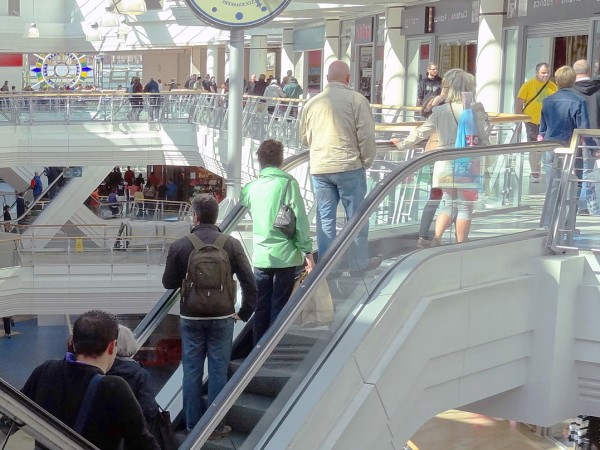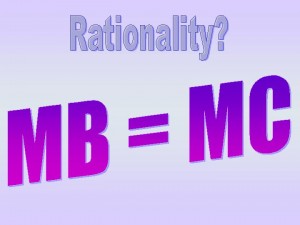 How important are emotions when you go shopping? Many people go shopping when they ‘need’ to buy something, whether it be a new outfit, food/drink, a new DVD release, a gift, etc. Others, of course, simply go window shopping, often with no intention of buying. However, everyone at some point has made a so-called ‘impulse’ purchase.
How important are emotions when you go shopping? Many people go shopping when they ‘need’ to buy something, whether it be a new outfit, food/drink, a new DVD release, a gift, etc. Others, of course, simply go window shopping, often with no intention of buying. However, everyone at some point has made a so-called ‘impulse’ purchase.
There is only one article below, which is from the BBC and draws on data released from the National Employment Savings Trust’s survey. This report suggests that British people spend over £1 billion every year on impulse buys – purchases that are not needed, were not intended and are often regretted once the ‘high’ has worn off. Often, it is the way in which a product is advertised or positioned that leads to a spontaneous purchase – seeing chocolate bars/sweets at the tills; a product offered at a huge discount advertised in the window of a shop; 2 for 1 purchases; points for loyalty etc. All of these and more are simple techniques used by retailers to encourage the impulse buy. As consumer psychologist, Dr. James Intriligator says:
Retailers have clever ways of manipulating customers to spend more but if you stick to your plans you can avoid being affected by their tactics.

In other cases, it’s simply the frame of mind of the consumer that can lead to such purchases, such as being hungry when you’re food shopping or having an event to attend the next day and deciding to go window shopping, despite already having something to wear! Dr. Intriligator continues, saying:
Your ability to resist and make rational choices is diminished when your glucose levels are down … When you get irrational, you fall back on trusted brands, which often leads you to spend more money … Later in the shop, you’re more tired and less likely to resist [impulse buys]
But are such purchases irrational? One of the key assumptions made by economists (at least in traditional economics) is that consumers are rational. This implies that consumers weigh up marginal costs and benefits when making a decision, such as deciding whether or not to purchase a product. But, do impulse buys move away from this rational consumer approach? Is buying something because it makes you happy in the short term a rational decision? Behavioural economics is a relatively new ‘branch’ of economics that takes a closer look at the decisions of consumers and what’s behind their behaviour. The following article from the BBC considers the impulse buy and leaves you to consider the question of irrational consumers.
Article
How to stop buying on impulse BBC Consumer (30/5/13)
Questions
- If the marginal benefit of purchasing a television outweighs the marginal cost, what is the rational response?
- Using the concept of marginal cost and benefit, illustrate them on a diagram and explain how equilibrium should be reached.
- What is behavioural economics?
- What are the key factors that can be used to explain impulse buys?
- How can framing help to explain irrational purchases?
- If a product is advertised at a significant discount, what figure for elasticity is it likely to have to encourage further purchases in-store?
- Is bulk-buying always a bad thing?
 A key economic principle is that rational decision making requires thinking at the margin. This involves a comparison of the additional (or marginal) benefits and costs of an activity.
A key economic principle is that rational decision making requires thinking at the margin. This involves a comparison of the additional (or marginal) benefits and costs of an activity.
An example of such rational behaviour would be deciding to drink one more beer or spending one more hour studying only if the additional benefits were greater than the additional costs. The optimum is where marginal benefit equals marginal cost.
And this applies to firms too. A firm maximises its profits by producing the output at which marginal revenue is equal to marginal cost.
 However, a recent book by the American business guru Clayton Christensen argues that thinking in this way can be a problem. A recent article in the Guardian describes a story he tells of the time he refused to play for his university basketball team in a national final which took place on a Sunday and therefore conflicted with his religious beliefs. His decision involved sticking to his principles rather than thinking at the margin. For him, whilst the marginal cost of sacrificing these principles just once may well have been small compared to the resulting benefits, the eventual cost would be much higher.
However, a recent book by the American business guru Clayton Christensen argues that thinking in this way can be a problem. A recent article in the Guardian describes a story he tells of the time he refused to play for his university basketball team in a national final which took place on a Sunday and therefore conflicted with his religious beliefs. His decision involved sticking to his principles rather than thinking at the margin. For him, whilst the marginal cost of sacrificing these principles just once may well have been small compared to the resulting benefits, the eventual cost would be much higher.
Christensen also suggests that similar arguments can apply to firm decision making. The above article provides an example he uses of decisions made by executives at the Blockbuster video chain. When smaller rivals started offering movies by mail, Blockbuster instead continued to invest in its existing video store business model. This eventually proved disastrous for the company. The explanation given for this is that building on previous investments made more sense than setting up a mail-order arm which would cannibalise their existing business. On the other hand, an alternative explanation may be that executives at Blockbuster were irrationally allowing sunk costs to affect their decision making.
Articles
Clayton Christensen’s “How Will You Measure Your Life?” Harvard Business School, Clayton Christensen (9/5/12)
Clay Christensen’s life lessons BloombergBusinessweek, Bradford Wieners (3/5/12)
Bust Blockbuster goes on the block Guardian, Ben Child (4/4/11)
Questions
- Can you think of a situation where you have decided to stick to your principles rather than think at the margin?
- Why does a firm maximise profit by producing the output at which marginal revenue is equal to marginal cost?
- What do you think are the main costs of setting up a mail-order business?
- Are these costs mainly fixed or variable costs?
- Why is it irrational to take sunk costs into account when making a decision?
- Can you think of a situation where you have been influenced by sunk costs?
The National Institute for Health and Clinical Excellence (NICE) is the independent agency in the UK charged, amongst other things, with assessing the cost-effectiveness of new drugs. In a report published on 19 November 2009, NICE found that the drug sorafenib, branded as Nexavar by its manufacturer, the German pharmaceutical company, Bayer AG, was not cost-effective. The drug can extend the life of terminally ill patients with liver cancer. However, it is very expensive, costing about £3000 per month per patient.
The NICE press release (see link below) quotes Andrew Dillon, the Chief Executive of NICE, as saying: “We were disappointed not to have been able to recommend the use of sorafenib, but after carefully considering all the evidence, including the proposed ‘patient access scheme’ in which the manufacturer offered to provide every fourth pack free, sorafenib does not provide enough benefit to patients to justify its high cost.”
Not surprisingly people suffering from liver cancer, and also various patient groups, were highly critical of the decision. But with a limited budget for the National Health Service and the increasing pressure to save costs in order to reduce the public-sector debt, many difficult choices like this have to be made.
What NICE attempts to do is a cost–benefit analysis of new drugs. Whilst costs can be difficult to measure, especially over the longer term, the benefits are much more problematic as they have to take into account the effects on the quality of people’s lives – something that will vary enormously from one patient to another. And then there are the effects on family and friends and on the economy. The measure used in the NHS and elswhere is the QALY – ‘quality-adjusted life year’. In paragraph 4.8 of the full NICE report (see link below), it was noted that
“the base-case ICER [incremental cost-effectiveness ratio] presented by the manufacturer was originally £64,800 per QALY gained and when the patient access scheme was included [where every fourth pack is supplied free to the NHS by Bayer] this went down to £51,900 per QALY gained. Both ICERs were substantially higher than those normally considered to be an acceptable use of NHS resources.”
2009/069 NICE appraisal of sorafenib for advanced hepatocellular carcinoma NICE press release (19/11/09)
Final appraisal determination Sorafenib for the treatment of advanced hepatocellular carcinoma (Full document) NICE (19/11/09)
NHS denies drug to cancer patients (video) ITN (on YouTube) (18/11/09)
Liver cancer drug ‘too expensive’ (including videos) BBC News (19/11/09)
UK’s NICE says Bayer liver cancer drug too costly Reuters (18/11/09)
Nice’s decision not to approve the liver cancer drug Nexavar is painful but necessary and Drug for terminal liver cancer patients ‘too expensive’Telegraph, Rebecca Smith (19/11/09)
NHS says it’s too expensive to keep you alive Telegraph, Janet Daley (19/11/09)
Bayer’s patent case hearing in HC today Tines of India (18/11/09)
Questions
- What makes the choice of whether to provide a particular drug to a pateint an ‘economic’ one?
- Imagine you were a person suffering from liver cancer. What evidence would you wish to bring to the government to persuade it to ignore NICE’s recommendation?
- Is the use of QALYs the best means of assessing the benefits of a drug? Explain.
- What are the arguments for and againist the NHS providing expensive drugs free to people on low incomes but charging a price well above the current prescription fee to those who could afford to pay? If such as scheme were introduced, on what basis should such a price be determined and should it be on a sliding scale according to people’s income and/or wealth?
The ‘tragedy of the commons’ refers to the overuse of common land. If people can freely graze their animals on such land and have no responsibility for maintaining it, then the land will be overused and everyone will suffer. The problem is that the benefit of using the land occurs to the individual whereas the cost is collectively incurred.
There are many modern examples of the tragedy of the commons and the articles below look at some of them. Perhaps surprisingly, not all cases of the use of common resources end in tragedy; some common resources are used sustainably. A more thorough analysis must involve deeper questions of human motivation and behaviour.
IT’s tragedy of the commons Datamation (IT Management) (8/4/09)
The Tragedy of the Commons TechFlash (7/4/09)
Encarta’s failure is no tragedy Guardian (7/4/09)
How Self-Interest Destroyed The Economy The Huffington Post (23/3/09)
What does The Pirate Bay ruling mean for the web? Telegraph (17/4/09)
Tragedy of the Commons The Manila Times (23/3/09)
Questions
- Explain how the tragedy of the commons arises and give some examples other than common grazing land.
- How and why does the tragedy of the commons occur in information technology? Consider the benefits and costs of the ‘fix’ to the problem advocated in the first linked article.
- Does the case of Wikipedia (see the third linked article) disprove the proposition that common resources will be overused?
- To what extent is free access to content (music, newspapers, videos, books, etc.) a tragedy of the commons? Is the only solution to devise an effective charging model that rewards content creators?
The first linked article below is from the American business magazine Forbes. It looks at the economics of football (‘soccer’) signings and, in particular, that of Robinho by Manchester City. In September 2008 the club was bought by an Abu Dhabi investment fund, controlled by Sheikh Mansour bin Zayed Al Nahyan, for £210 million. But does the investment in new players make good business sense?
Also, what should determine whether a club sells a player? The third link below considers this issue. The link is to the Embedding Threshold Concepts (ETC) site at Staffordshire University. ETC was funded by the Higher Education Funding Council for England’s Fund for the Development of Teaching and Learning (FDTL). The site has a number of teaching and learning resources.
City of Dreams Forbes (8/4/09)
Man City beat Chelsea to Robinho BBC Sport (1/9/08)
Selling footballers: the economic viewpoint ETC reflective exercise
Questions
- Was it consistent with the goal of profit maximisation for Manchester City pay Real Madrid £32.5 million for Robinho? Was it consistent with the goal of profit maximisation for Real Madrid to sell him?
- If Real Madrid had decided to keep Robinho, how would you estimate the cost of doing so?
- What difficulties are there in developing Manchester City into a ‘global brand’?
- In what sense are the top Premier League clubs a ‘self-perpetuating oligopoly’?
 How important are emotions when you go shopping? Many people go shopping when they ‘need’ to buy something, whether it be a new outfit, food/drink, a new DVD release, a gift, etc. Others, of course, simply go window shopping, often with no intention of buying. However, everyone at some point has made a so-called ‘impulse’ purchase.
How important are emotions when you go shopping? Many people go shopping when they ‘need’ to buy something, whether it be a new outfit, food/drink, a new DVD release, a gift, etc. Others, of course, simply go window shopping, often with no intention of buying. However, everyone at some point has made a so-called ‘impulse’ purchase.

